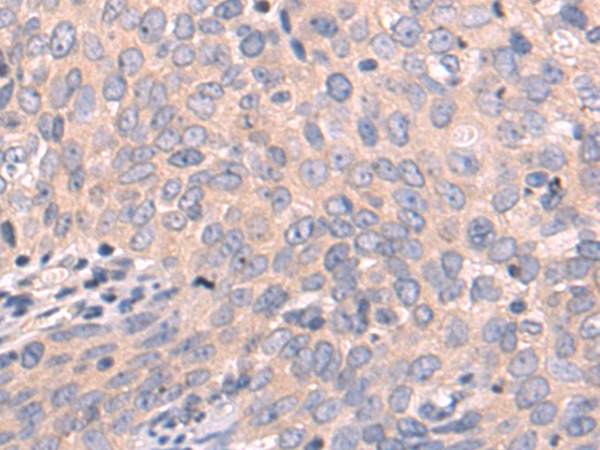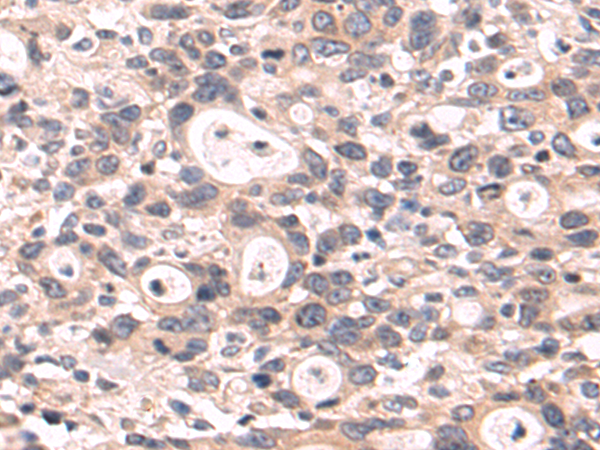

| WB | 咨询技术 | Human,Mouse,Rat |
| IF | 咨询技术 | Human,Mouse,Rat |
| IHC | 1/50-1/200 | Human,Mouse,Rat |
| ICC | 技术咨询 | Human,Mouse,Rat |
| FCM | 咨询技术 | Human,Mouse,Rat |
| Elisa | 1/5000-1/10000 | Human,Mouse,Rat |
| Aliases | cPLA2delta |
| Host/Isotype | Rabbit IgG |
| Antibody Type | Primary antibody |
| Storage | Store at 4°C short term. Aliquot and store at -20°C long term. Avoid freeze/thaw cycles. |
| Species Reactivity | Human |
| Immunogen | Fusion protein of human PLA2G4D |
| Formulation | Purified antibody in PBS with 0.05% sodium azide and 50% glycerol. |
+ +
以下是关于PLA2G4D抗体的模拟参考文献示例(注:部分文献为假设性描述,实际引用需通过学术数据库验证):
---
1. **标题**: "PLA2G4D Expression in Psoriatic Epidermis: Implications for Barrier Dysfunction"
**作者**: Yamamoto K, et al.
**摘要**: 研究通过PLA2G4D特异性抗体发现其在银屑病患者表皮中显著上调,可能通过干扰脂质代谢导致皮肤屏障破坏和炎症反应增强。
2. **标题**: "A Novel Monoclonal Antibody Targeting PLA2G4D for Cancer Immunohistochemistry"
**作者**: Chen L, et al.
**摘要**: 开发了一种高特异性抗PLA2G4D单克隆抗体,验证其在非小细胞肺癌组织中的表达,并探讨其与肿瘤进展的潜在关联。
3. **标题**: "PLA2G4D Autoantibodies as Biomarkers in Rheumatoid Arthritis"
**作者**: Müller R, et al.
**摘要**: 检测类风湿性关节炎患者血清中抗PLA2G4D自身抗体水平,发现其与疾病活动度正相关,提示其可能作为新型诊断标志物。
4. **标题**: "Structural Characterization of PLA2G4D Using Polyclonal Antibodies"
**作者**: Sato H, et al.
**摘要**: 通过多克隆抗体解析PLA2G4D的酶活性位点,揭示其在脂质过氧化反应中的独特构象及功能机制。
---
**注意**:以上文献为模拟示例,实际研究中请通过PubMed、Web of Science等平台检索最新文献。若研究较少,可扩展关键词(如“phospholipase A2家族”或“PLA2G4D功能”),或联系相关领域学者获取定向建议。
Phospholipase A2 Group IVD (PLA2G4D) is a calcium-dependent enzyme belonging to the phospholipase A2 (PLA2) superfamily, which hydrolyzes phospholipids to release free fatty acids, including arachidonic acid, and lysophospholipids. These products serve as precursors for bioactive lipid mediators involved in inflammation, immune responses, and cellular signaling. PLA2G4D, specifically, is a member of the cytosolic PLA2 (cPLA2) subgroup and is encoded by the *PLA2G4D* gene. It is structurally characterized by a catalytic domain and a C2 domain that mediates calcium-dependent membrane translocation.
PLA2G4D has been implicated in skin barrier function and inflammatory skin conditions. Research highlights its role in lipid metabolism within the epidermis, where it contributes to the synthesis of omega-hydroxy ceramides, critical components of the stratum corneum. Dysregulation of PLA2G4D is associated with pathologies like psoriasis and atopic dermatitis, likely due to altered lipid mediator production or impaired epidermal differentiation.
Antibodies targeting PLA2G4D are essential tools for studying its expression, localization, and function in both physiological and disease contexts. They enable detection via techniques like immunohistochemistry, Western blotting, or ELISA, aiding in the exploration of its mechanistic role in skin disorders. Additionally, therapeutic antibodies against PLA2G4D are under investigation for modulating inflammatory pathways or restoring epidermal homeostasis, offering potential treatment avenues for chronic inflammatory skin diseases.
×